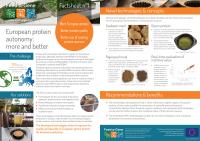Factsheet N°1 European protein autonomy: more and better
 The challenge
The challenge
Europe has for long been deficient in protein for its livestock production. Although rapeseed meal (RSM) is increasingly produced in Europe, its use for monogastric animals is hampered by its lower content and digestibility of protein and amino acids compared to soybean meal (SBM).
European-grown soybeans and protein from green biomass are promising alternatives to imported SBM. However, little is known about how processing technologies can be used to improve the nutritional value of these locally-produced protein sources.
Non-conventional feed ingredients vary more in nutrient content and value than conventional ones. Advances in near-infrared spectroscopy (NIRS) make it a promising tool for predicting nutrient content and value in real-time.
Our solutions
The Feed-a-Gene project has worked with:
- Technologies for the processing of European soybeans, green biomass and rapeseed meal
- Biotechnologies to improve feed quality
- Nutritional evaluation for pigs and poultry
- NIRS for the real-time determination of nutritional value
These technologies and methodologies allow to increase protein production in Europe, make a better use of existing European protein sources, and evaluate their nutritional value in real-time.
The developed technologies allow to improve the quality and quantity of European-grown protein for livestock production.